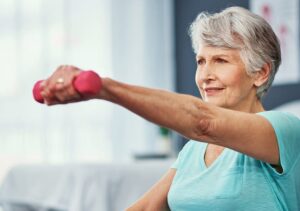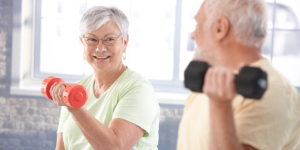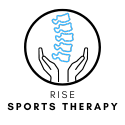STRENGTH TRAINING FOR OSTEOPOROSIS
Strength training consists of exercises, performed in sets using either just your body weight, resistance bands, or weights. As the name suggests, it helps to build strength by improving muscle quality.
The benefits of strength training don’t just stop at improved muscle quality though. It also has the following benefits:
- Builds and maintains muscle mass
- Makes your joints stronger
- Supports weight loss and weight management
- Improves cardiovascular health
- Protects bone health
- Improves your mood and mental health
- May actually help you live longer

This blog is going to focus on point 5, and how strength training can protect bone health. Studies have shown that strength training over a period of time can help prevent bone loss, and in some circumstances may even help build new bone. Maintaining strong muscles through weight training also helps to keep your co-ordination and balance , a critical element in preventing falls, which can lead to osteoporosis-related fractures.
Osteoporosis should really be a concern for us all. A combination of age-related changes, inactivity, and inadequate nutrition gradually lead to a decrease in bone mass, at the rate of 1% per year from the age of 40.
According to the Royal Osteoporosis Society, those at risk of, or suffering from Osteoporosis should aim to do the following in terms of strength training:
- Exercise 2-3 days a week, on non-consecutive days
- Aim for 20-30 minutes working on exercises that target legs, arms, and the spine
- Work gradually with resistance bands and weights (8-12 reps)

Before You Start
Before starting a new exercise program for Osteoporosis, it is always advised that you consult your doctor first. They may want to carry out some tests, including a Bone Density Scan.
Strength Training
Strength training can include the use of free weights, resistance bands, or just body weight. The strength program should be tailored to your ability and tolerance. Proper form and technique are also crucial to prevent injury and get the most out of the workout.
Weight-Bearing Aerobic Exercises
Weight-bearing aerobic activities involve doing aerobic exercise on your feet, with your bones supporting your weight. Examples of this include dancing, elliptical machines, and gardening. These exercises generally work directly on the bones in your legs, hips and lower spine to slow mineral loss. Although walking is often prescribed to prevent Osteoporosis, it has actually been shown to have little to no effect on bone loss.
Osteoporosis Strength Workout
If you don’t feel comfortable exercising on your own, then why not attend a ‘Chair Based Exercise’ class. Not only will you be strength training, but you will also have the opportunity to meet others in similar situations to yourself and have fun at the same time!
